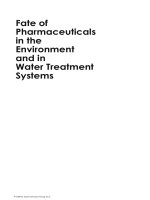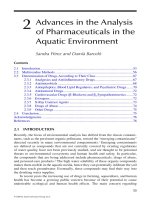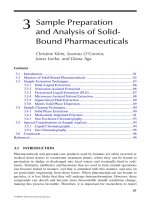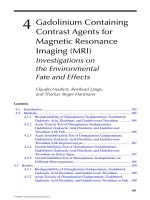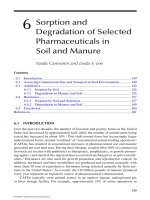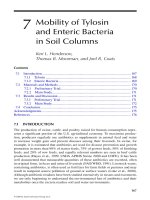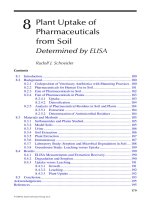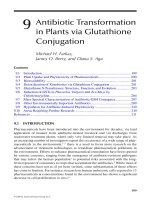Fate of Pharmaceuticals in the Environment and in Water Treatment Systems - Chapter 3 pdf
Bạn đang xem bản rút gọn của tài liệu. Xem và tải ngay bản đầy đủ của tài liệu tại đây (347.91 KB, 20 trang )
81
3
Sample Preparation
andAnalysisofSolid-
Bound Pharmaceuticals
Christine Klein, Seamus O’Connor,
Jonas Locke, and Diana Aga
3.1 INTRODUCTION
Pharmaceuticals and personal-care products used by humans are often excreted or
washed down drains to wastewater treatment plants, where they can be bound to
particulateinsludgeordischargedintolocalwatersandeventuallybindtosedi-
ments. Similarly, antibiotics and hormones that are used in farm animal operations
canbecomeboundtomanure,soilthatisamendedwiththismanure,andalsoon
air particulate originating from those farms. When pharmaceuticals are bound to
particles, it is less likely that they will undergo biotransformation. However, these
compounds can desorb and become more bioavailable should conditions change,
makingthisprocessfavorable.Therefore,itisimportantforresearcherstoreport
Contents
3.1 Introduction 81
3.2 Matrices of Solid-Bound Pharmaceuticals 82
3.3 Sample Extr act ion Tech n iques 83
3.3.1 Solid–Liquid Extraction 86
3.3.2 Sonication-Assisted Extraction 86
3.3.3 Pressurized Liquid Extraction (PLE) 87
3.3.4 Microwave-Assisted Solvent Extraction 88
3.3.5 Superc r itical Fluid E xt ract ion 89
3.3.6 Matrix Solid Phase Dispersion 89
3.4 Sample Cleanup Techniques 90
3.4.1 Solid Phase Extraction 90
3.4.2 Molecularly Imprinted Polymers 91
3.4.3 Size Exclusion C hromatography 93
3.5 Spe cial Considerations in Sa mple Ana lysis 94
3.5.1 Liquid Chromatography 94
3.5.2 Gas Chromatography 95
3.6 Conclusion 96
References 96
© 2008 by Taylor & Francis Group, LLC
82 Fate of Pharmaceuticals in the Environment and in Water Treatment Systems
the fraction of pharmaceuticals that are bound to solids in environmental studies
insteadofjustconcludingthatthepharmaceuticalhasbeenbiodegradedorother-
wiseremovedfromthesystem.
The extent to which these compounds become bound to solids can be character-
izedbyacompound’sKd(asolid-waterpartitioningcoefcient)value.SeeChapter
6 for more information on sorption processes. The environmental solids these phar-
ma
ceuticals can bind to are diverse in composition. Because the degree of binding
depends highly on the nature of the sorbent-sorbate interactions, the available meth-
ods for extraction of pharmaceuticals from solid matrices vary widely. Hence, the
applicabilityofextractionandanalyticalmethodsneedstobeevaluatedfordifferent
pharmaceutical compounds, and conditions need to be optimized for various types
of solids.
Onceanextractionmethodisfoundtobesuitableforremovingsorbedpharma-
ce
uticalsfromenvironmentalsolids,itisoftennecessarytoperformsomedegreeof
cleanuponthesesamplesbeforedetectionandquantication.Environmentalmatri-
cessuchasmanure,soil,sludge,andsedimentallcontainnaturalorganicmatter
(NOM),whichisgenerallydescribedasapoorlydenedmixtureoforganicsub-
stanceswithvariablepropertiesintermsofacidity,molecularweight,andmolecular
structure. Many times extraction methods will coextract portions of the environmen-
talmatrix,whichcaninterferewithanalysisinavarietyofways.Throughextraction
and cleanup, one is able to remove many matrix interferences; however, the more
extensive these procedures are, the greater the possibility becomes for analyte loss.
Additionally, because the levels of pharmaceuticals are low, these samples will often
need to be preconcentrated in order to be detectable even by the most modern instru-
me
ntation. Unfortunately, this also leads to the concentration of interferences, which
are generally much more abundant in a sample than the analytes themselves.
The extent to which samples containing solid-bound pharmaceuticals are
manipulated, and the best overall analytical method used, depends on several fac-
to
rs.Aswhenpreparingmostenvironmentalsamples,ananalystmustbalancethe
advantages and disadvantages of extraction, cleanup, and concentration techniques.
Compromises are often made, and these decisions are ultimately driven by factors
such as the required detection limit for the purpose of the study, analytical instru-
me
ntation available, the amount and type of extracted material that contaminates a
sample, and the concentrations of analytes present in the samples. This chapter will
review various sample preparation strategies employed in the analysis of pharma-
ce
uticalsinsoil,manure,andsludgeanddiscusstheadvantagesandlimitationsof
each technique.
3.2 MATRICES OF SOLID-BOUND PHARMACEUTICALS
Solid-boundpharmaceuticalshavebeenfoundinmatricesrangingfromhousehold
and farm dust to the sediments that receive treated wastewater. Assessing the chemi-
calcompositionofasampleandknowledgeofpropertiessuchaspolarityandbind-
ingsitescanhelpananalystdeterminethebestextractionmethodtodesorbtheir
analytefromthematrixandbestcleanupmethodtoremoveinterferingmatrixcom-
ponents.Additionalsamplepreparationstepssuchassampledrying,eitherbyairor
© 2008 by Taylor & Francis Group, LLC
Sample Preparation and Analysis of Solid-Bound Pharmaceuticals 83
freeze-drying methods, or mechanical separation by sieving and grinding must be
takenintoconsiderationbecauseoftheirlaborintensivenessandeffectonthetime
ittakestoprepareasample.Ingeneral,thelessnaturalorganicmattercontentin
amatrix,theeasieritistoextractorganicanalytes.Forexample,whencomparing
extraction efciencies from different soil types, higher recoveries for tetracyclines
(TCs)areo bserved in sandier soil than in soil with more organic matter.
1
The compositions of typical matrices encountered when conducting environmen-
tal analysis are described in this section. Air particulate has been found to contain
antibacterial agents such
as triclosan
2
in household dust and tetracyclines, sulfa-
methazine,tylosine,andchloramphenicolinanimalconnementbuildings.
3
The
dust from the interior of an animal connement building was analyzed and found
to contain approximately 85% organic material, composed of protein (from skin),
animal feed, endotoxins, fungi, and bacteria.
4
This composition will vary, depending
on the source.
Sludges have been found to be contaminated with a variety of compounds
ranging from personal-care products and pharmaceuticals, which are washed and
usheddowndrains,tohormonesandantibiotics,whichareusedinanimalpro
-
duction. Wastewater sludge contains many compounds and is primarily organic in
nature.Thecompositionofthisorganicportionofsludgeismadeupofsugars,pro
-
teins, fatty acids, cellulose, and plant macromolecules with phenolic and aliphatic
structuresbutisstillnotcompletelycharacterized.
5
It also has microorganisms and
exocellularmaterialandresiduesoriginatingfromwastewater(forexample,paper
plant residues, oils, fats, and fecal material).
6
Sludgesfromdifferentsourcescan
have enormous compositional variation, which necessitates validation of the extrac-
ti
on efciency for each sludge source.
7
Sediment is comprised of the particulate in surface waters that settles to the
bottom of the water column or remains suspended and transported in waterways.
Sediment particles have both organic and inorganic fractions, which can contain
humic material; metal oxides such as iron and manganese; and also trace metals,
silicates, sulphides, and minerals.
8
Theparticlesizeofsedimentsisoftenindicative
ofitscomponentsandwilldeterminethetypesofcompoundsthataresorbedtoit;
therefore, it often needs to be sieved during its preparation before it is extracted for
contaminants.
So
il is made from eroded earth that is mixed with decayed plant and animal tis-
su
es.Itcontainsmostlyorganiccarbon,inorganicclays,andsand.Pharmaceuticals
arefoundinsoilwhenitisamendedwithsludgesandmanuretogi
ve it more nutrient
content in the form of carbon and nitrogen. Like sediment, soil needs to be sieved
before analysis.
3.3 SAMPLE EXTRACTION TECHNIQUES
Pharmaceuticals that are bound to solids must be removed, or extracted, from these
solidspriortoanalysis.However,astandardmethodforextractiondoesnotexist,
and an extraction procedure must be optimized for the conditions that an analyst
encounters. One of the most widely used methods for assessing the efciency of an
extractionprocedureisbydeterminingthepercentrecoveryandextractionyieldof
amethodthroughspikingexperiments.Inthistypeofexperimentananalystwill
© 2008 by Taylor & Francis Group, LLC
84 Fate of Pharmaceuticals in the Environment and in Water Treatment Systems
take a sample of the matrix that they want to extract a compound from, add a known
amount of that compound, and extract it using the selected method to determine
howmuchisremoved.Issuesthatmustbeconsideredwhenperformingthistypeof
experimentare(1)solventselection;(2)contacttime;(3)spikinglevel;and(4)pos
-
s
i
ble effects on binding/transformation by the microbial community present in the
sample.Italsoisimportanttovalidatemethodswhencomparingextractionofdif
-
fe
rent types of solids because efciencies can differ, leading to gross underestima-
t
i
on or overestimation of analyte concentration. Simply adding an internal standard
does not excuse the validation of an extraction procedure, because the contact time
withthesolidsmaynotbeappropriateforassessingextractionefciency.
Solvent selection is probably the most important step in developing an extraction
methodforsolid-boundpharmaceuticals.Theanalyteshouldhavehighsolubilityin
the extraction solvent in order to desorb the analytes efciently. Many pharmaceuti
-
calcompounds,suchasantibioticsandhormones,havelowwatersolubilityandare
relatively hydrophobic, making it necessary to use organic solvents for extraction.
Butevenwhenpharmaceuticalshavehighwatersolubility,Kdmaybehighdueto
interactions other than hydrophobic.
9
Pressurized liquid extraction (PLE) and super-
criticaluidextraction(SFE)techniquescanleadtohigherextractionefciencies
relative to traditional solid–liquid extraction. Solvent modiers such as acids or bases
are sometimes added to extraction solvents to increase the solubility of analytes in
the extraction solvents and to improve extraction efciencies. Some compounds such
astetracyclinesareknowntoformcomplexeswithdi-andtrivalentcationsinthe
clay minerals or to hydroxyl groups at the surface of soil particles.
10–12
Hence, com-
plexingagentssuchasethylenediaminetetraaceticacid(EDTA)areoftenaddedto
the extraction buffer to improve percent extraction recovery.
13
Thecontacttimeoftheanalytewiththesolidmatrixpriortoextractionisan
important parameter to consider when validating and optimizing extraction proce-
d
u
res. It has been shown for 17B-
estradiol a
nd sulfonamide antibiotics that the longer
thecontacttimebetweenthesoilandtheanalytes,thelowerthepercentextraction
recoveries obtained.
14,15
In addition, when short contact time between the solid and
theanalytewasallowedpriortoPLEextraction,temperaturehadlittleeffectonthe
extraction efciencies of the spiked soils. However, when 17 days of contact time
wasallowed,anincreaseinextractiontemperaturesignicantlyimprovedpercent
recoveries.
15
Spiking a solid matrix at environmentally relevant concentrations is also impor-
tant when determining extraction efciency. It may be tempting for an analyst to
spike at higher levels because this can alleviate problems associated with detection.
However, this can mislead one into believing that the extraction efciency is higher
or more reproducible than it actually is at the lower concentrations typically observed
in the natural environment. For instance, in an experiment conducted in our labora
-
t
o
ry to nd optimized extraction conditions for tetracyclines from soil, the percent
recovery at low concentrations was signicantly higher than at the spiked concen
-
tr
ations.Whensoilwasspiked(n=3)atconcentrationsof100ng/g,therecoveries
oftetracyclinesrangedfrom89to92%,withstandarddeviationsatorbelow10%
(see
Table 3.1). H
owever, w
hen the spiking levels approached environmentally rel-
evant concentrations (below 20 ng/g), exaggerated recoveries (>100%) and very high
© 2008 by Taylor & Francis Group, LLC
Sample Preparation and Analysis of Solid-Bound Pharmaceuticals 85
standard deviations (>50%) were observed, suggesting signicant matrix interfer-
ence that is highly variable.
Microbial communities present in the matrix could potentially alter the sorp-
ti
on of pharmaceutical compounds in soil via biodegradation or biotransformation.
Therefore,itisimportanttoensurepropersamplestorageandtoaccountforpossi-
bl
e biodegradation when evaluating extraction methods. For instance, the extraction
recoveries for ibuprofen were improved from 25 to 94%, and for trimethoprim from
68 to 86%, when the solid samples were rst autoclaved before fortication with the
analytes,demonstratingtheinuenceoflivemicrobialcommunityontheamount
ofrecoveredpharmaceuticals.Itispossiblethatduringthecontacttimeof14hours
used in the study, the microorganisms have either incorporated the pharmaceuticals
into the organic matter content of the soil or have degraded the pharmaceuticals into
other compounds that were not monitored by the method. The adsorption isotherms
for these compounds in sediment remained unaltered by the autoclaving process,
despite the potential effects of autoclaving on the sediment, organic matter, and cat
-
i
o
n-exchange capacity.
16
Tetracyclines and hormones (such as estrogens) that are introduced into the envi-
ronment present unique challenges that are not encountered in other biological or
food samples. For instance, the strong interaction of tetracyclines with natural organic
matter and with clay components in soil can lead to poor extraction efciencies and
large variability in percent recoveries.
17
While tetracyclines are fairly polar (Kow
0.8), the zwitterionic character of these compounds causes them to complex with ions
TABLE 3.1
Tetracycline Recoveries in Soil Using Accelerated
Solvent Extraction (ASE) and Solid Phase Extraction
(SPE) Cleanup (n = 3)
Spiking Concentration
Tetracycline/Soil
Tetracycline
Compound
Percent
Recovery
Standard
Deviation
100 ng/g TC 91% 3%
100 ng/g OTC 89% 10%
100 ng/g CTC 92% 6%
50 ng/g TC 140% 10%
50 ng/g OTC 151% 5%
50 ng/g CTC 155% 10%
25 ng/g TC 140% 47%
25 ng/g OTC 138% 47%
25 ng/g CTC 171% 50%
Note: As spiking level approaches environmentally relevant concentra-
tions below 25 ng/g, recovery becomes less reproducible.
TC = Tetracycline
OTC = Oxytetracycline
CTC = Chlortetracycline
© 2008 by Taylor & Francis Group, LLC
86 Fate of Pharmaceuticals in the Environment and in Water Treatment Systems
present in soil or sludge. Estrogens, on the other hand, are fairly nonpolar (Kow 4.2)
andthushavehighsorptiontosolidmatriceswithhighorganicmattercontent.
3.3.1 SOLID–LIQUID EXTRACTION
Solid–liquid extraction is the most basic extraction method for solid samples. It
involvesmechanicalagitationofamixtureconsistingofthesampletobeextracted
andanexcessofsolvent.Thesolventandsampleareextractedforaperiodoftime,
typicallylongerthan10minutes.Inatypicalsolid–liquidextraction,thesampleis
then centrifuged, and the supernatant is removed and extraction is repeated several
times.Thesupernatantsarecombined,atwhichtimethesamplecanbeanalyzed,
or more typically the extract volume is reduced to facilitate analysis. This can be
achieved through several different methods and is often dependent on the equipment
available and the analyte being examined. Solid–liquid extraction is simple and cost
effective,sincetheequipmentneededisminimal.However,onemajordrawback
is the relatively large amount of solvent used for this technique compared with the
other techniques discussed below.
Solid–liquidextractionhasbeenusedtoexamineavarietyofpharmaceuticals
in environmental solids. Steroid estrogens, such as estradiol, estrone, estriol, and
ethinylestradiol, have been extracted from sediment and sewage sludge with percent
recoveryrangingfrom61to71%.
18
In another study, the effect of solvent composi-
tionwasexaminedforextractingtetracyclinesfromsediment,anditwasfoundthat
higher citric acid concentration (0.1%) in the solvent improved extraction efcien
-
ci
es up to 105%. However, as the concentration of the chelating agent Na
2
EDTA
increased, the extraction efciency decreased.
19
This conicts with other reports that
suggest that the addition of EDTA into the extraction solvent improves extraction
efciency by releasing metal-complexed tetracyclines.
20
Solid–liquidextractionhasalsobeenusedtodeterminetheconcentrationsofthe
antibioticstylosin,sulfamethazine,chloramphenicol,andtetracyclinesfromthedust
foundinananimalconnementshelter;however,therecoverieswerenotreported.
3
Information on recoveries would have been interesting because the concentration in
dust is typically very low. Although solid–liquid extraction is frequently used in the
analysisofawiderangeofpharmaceuticals,itsuseislimitedbecausecompounds
thatarestronglysorbedtoasolidmatrixmayneedmorerigorousextractioncondi
-
t
i
ons, such as those provided by the other techniques discussed below.
3.3.2 SONICATION-ASSISTED EXTRACTION
Insonicationassistedextraction(SAE)samplesaremixedwithanextractionsol-
ventandplacedintoasonicationbath.Thesamplemixtureissubjectedtoacoustic
vibrations with frequencies above 20 kHz. These ultrasonic waves travel through the
sample, leading to expansion and compression cycles in the solvent. The expansion
cycles cause a negative pressure in the liquid, and if the amplitude of these waves
is strong enough, cavities or bubbles in the solvent can be observed. Upon the col
-
lapse of these bubbles, localized temperatures and pressures can exceed 5000 K and
1000 atm, respectively, creating shockwaves which in turn increase the desorption
© 2008 by Taylor & Francis Group, LLC
Sample Preparation and Analysis of Solid-Bound Pharmaceuticals 87
of analytes from the matrix surface.
21
Additionally, the collapse of these bubbles in
the presence of suspended particles can lead to asymmetric collapses that form high-
speedmicrojetstowardthesolid’ssurface,leadingtoerosionandcleavages.The
increase in surface area also improves extraction of analytes.
22
This technology has
been used for the extraction of pharmaceuticals and natural hormones from matrices
such as manure and soil amended with manure,
23,24
and sludge,
7
but primarily in
river sediments.
16,25–28
Inastudythataimedtodetermineantibioticsinpigslurry,sonicationwasused
with a solvent system composed of methanol, McIlvane buffer, and EDTA. The
recoveriesforoxytetracyclineandsulfachloropyridazinerangedfrom77to102%
and58to89%,respectively,usingaconcentrationrangeof1to20mg/L.Asimi
-
la
r extraction method (with methanol added in the solvent) was used to extract soil
thatwasspikedatconcentrationsrangingfrom0.2to0.5ug/g.Therecoverieswere
reportedas27to75%,68to85%,and47to105%foroxytetracycline,sulfachloro
-
pyridazine,andtylosin,respectively,infourdifferenttypesofsoils.Ingeneral,lower
recoveries were observed in soils with higher clay and organic carbon content, espe
-
ci
allyforoxytetracyclineandtylosin,whichhavehigherKdvalues.
24
However, the
spiking levels used in these studies are orders of magnitude above environmentally
relevant concentrations, and therefore these methods may not be applicable to real
environmental samples. Additionally, no mention is made regarding the contact time
used during the recovery studies; this ignores the effect of aging on the extractability
of pharmaceuticals from soil. Similarly, estrogen analysis was attempted in freeze-
driedsolidsfromhoglagoonsamplesusingsonicationandamethanol/acetonemix
-
tu
re as an extraction solvent.
23
However, extraction recoveries were not reported;
hence, no assessment can be made on how successful the sonication method is for
estrogen extraction from solids.
3.3.3 PRESSURIZED LIQUID EXTRACTION (PLE)
PLE, also known as accelerated solvent extraction (ASE), involves the use of pres-
surized extraction vessels at elevated temperatures to achieve efcient extraction of
analytes. The sample is placed in an extraction cell with an inert solid dispersant.
Thesoliddispersant,suchassandordiatomaceousearth,servesatwofoldpurpose.
First,itllstheemptycellvolumetominimizeexcesssolventconsumption,and
second, it increases the surface area of the sample that is exposed to the extrac
-
ti
on solvent. The lled extraction cell is then pressurized with extraction solvent
andplacedinanoventoincreasethetemperature.Highertemperaturesincrease
solubility of analytes in the solvent and decrease viscosity of the solvent, leading to
betterpenetrationintointerstitialspacespresentinthesample.Additionally,raising
the temperature increases extraction kinetics such as desorption. Elevated pressures
also contribute somewhat to increasing solvent contact with the sample, but mainly
theyservetokeepthesolventsliquidattheincreasedtemperature.PLEoffersthe
advantage in many cases of automation, leading to increased sample throughput.
Furthermore, PLE reduces the solvent requirement to extract samples, saving on
analysis cost and minimizing organic solvent waste.
© 2008 by Taylor & Francis Group, LLC
88 Fate of Pharmaceuticals in the Environment and in Water Treatment Systems
In studies that compare the effects of solvent, temperature, pressure, and time
using PLE, solvent selection generally has the most signicant effect, followed by
temperature.
15,29
Another parameter that is often optimized in PLE is the number of
extraction cycles and the need to prewet the soil.
29
However, it appears that for some
compounds, such as uoroquinolones, the best extraction recovery is obtained with
no prewetting of the solid sample.
Thermal degradation studies must be conducted when using elevated tempera
-
tu
res in PLE. Typically, they are conducted by spiking the analytes on quartz sand
andextractingthesandbyPLEatvarioustemperaturesettings.Itisimportantto
assess the effect of high temperature on the stability of the analytes because some
pharmaceutical compounds are thermally labile. Another important consideration is
the amount of sample used for extraction. The amount of sample must be minimized
(5 to 10 g) to avoid unnecessary extraction of large amounts of organic matter and
other matrix components.
15
Acoextractedmatrixnotonlyinterfereswiththeanalyte
detection, but could also clog the extraction vessels, as has been observed during
the extraction of 25 g soil.
1
Furthermore, additives and buffers that are used in other
extraction methods can precipitate and clog the lines of the PLE apparatus.
1
PLE has
been used to extract tetracyclines,
1
macrolides, ionophores, sulfonamides, uoroqui-
nolones,
29,30
and estrogens
31,32
fromsoil,sludge,andsediments.
3.3.4 MICROWAVE-ASSISTED SOLVENT EXTRACTION
Another emerging technique in environmental analysis is microwave-assisted extrac-
tion(MAE).Thistechniqueinvolvestheuseofmicrowavestoheatasampleina
closed vessel so that temperatures above the normal boiling point of the extraction
solvent can be utilized. The increased temperature improves analyte solubility, extrac
-
ti
on kinetics, and solvent contact (wetting) with the matrix, similar to PLE. The main
advantages of MAE include: decreased extraction time, increased sample through
-
pu
tbymeansofautomatedandsimultaneousextractionofseveralsamples,and
decreasedsolventconsumptionrelativetosoxhletextraction.Thedisadvantagesto
usingMAEforsoilextractioninclude:thermaldecompositionofanalytes,nonselec
-
ti
ve extraction of matrix components, and limited solvent choices. Only microwave-
active solvents such as water and methanol can be used; nonpolar organic solvents
such as hexane, cyclohexane, and methylene chloride are not useable in MAE.
MAEhasbeensuccessfullyusedfortheextractionofestrogensfromsediments
33
and quinolone antibiotics from soils and sediments.
34,35
It should be noted, however,
that during extraction, estradiol was oxidized to estrone in sediment
c
ontaining low
organic matter.
33
It was suspected that the manganese oxides present in the sediment
have catalyzed this reaction when exposed to microwaves. The study by Morales-
Munoz
35
showedtheimportanceofsolventpHwithrespecttotheanalyteandpKa/
ionizablefunctionalgroups.Whenananalyteisprotonatedordeprotonated,its
solubility in water (used as the extracting solvent) is increased. The study by Prat
34
illustrates the advantages of using MAE over conventional extraction techniques.
For instance, the use of MAE in a 15-minute extraction of uoroquinolone resulted
in approximately 80% recovery, while 1-hour of mechanical shaking resulted in less
© 2008 by Taylor & Francis Group, LLC
Sample Preparation and Analysis of Solid-Bound Pharmaceuticals 89
than 40% recovery. Further, MAE allowed recoveries of greater than 90% using
threeextractioncyclesforuoroquinolonefromsoil.
35
3.3.5 SUPERCRITICAL FLUID EXTRACTION
SFEexploitsthepropertiesofauidwhenelevatedtemperaturesandpressuresare
appliedabovetheircriticalpoint.Becauseasupercriticaluidexhibitsthermaland
physicalpropertiesofbothaliquidandagas,thesurfacetensionisnonexistent,
causing the diffusivity to increase. This affords supercritical uids the ability to
readily penetrate porous and brous solids, including environmental matrices. An
advantageofusingSFEisthatitisoftenconductedusingcarbondioxide;therefore,
largeamountsoforganicwastesarenotgenerated.
The use of SFE affords the user a higher degree of selectivity, with minimum
amount of coextracted matrix obtained relative to the other extraction techniques. For
example, SFE was reported to produce the cleanest soil extracts compared to other
methods, such as PLE.
36
SFE has been used to extract nonsteroidal antiinammatory
drugs (NSAIDs) from river sediment,
28
as well as 4-nonylphenol and bisphenol A
from sludge.
37,38
TherecoveriesofNSAIDssuchasnaproxenandketopronfrom
riversedimentusingSFEwerecomparabletotherecoveriesobtainedusingPLE(78
to 79%) and MAE (81 to 82%). On the other hand, the recoveries of 4-nonylphenol
and bisphenol A were disappointing and were lower than the recoveries observed
using PLE. However, the only parameter that was altered in SFE was the solvent
composition;itmightbepossibletoobtainhigherrecoveriesifotherSFEextraction
parameters are optimized.
3.3.6 MATRIX SOLID PHASE DISPERSION
Matrix solid phase dispersion (MSPD) is another technique that can be used for
extraction of analytes from solid samples. Briey, this technique uses a solid phase
sorbent, usually octadecylsilyl silica packing material similar to those used in
reversed phase high-performance liquid chromatography (HPLC) and solid phase
extraction (SPE). This s
olid phase is conditioned with the appropriate solvents and
thenmixedwiththesolidsampleusingamortarandpestle.Themixtureisthen
transferred to a column, and the analytes are eluted with organic solvents. This
extraction procedure offers the advantage of providing direct contact between the
solidextractingmaterialsandtheanalytesinthesolidsample.Thelargesurface
area of the derivatized silica particles used in MSPD facilitates efcient transfer of
analytes from soil to the extracting solid phase.
MSPD has been applied in the analysis of tetracycline antibiotics in several food-
relatedmatrices,suchasmilkandcatshtissue,buttherehasbeennoreportonits
application in the analysis of tetracyclines in soil.
39–41
Usinganoctadecylsilylderiva-
tizedsilicasolidphase,withoxalicacidandEDTAasmodiers,recoveryfrom
catshtissuewas81%withalimitofdetection(LOD)of50µg/kg.
40
The method
wasslightlymorevariablewhenusingmilksamples,withrecoveriesrangingfrom
64 to 94%.
41
The extraction of steroids such as estradiol, testosterone, and proges-
terone, were compared in poultry, porcine, and beef meats. Using MSPD, extraction
© 2008 by Taylor & Francis Group, LLC
90 Fate of Pharmaceuticals in the Environment and in Water Treatment Systems
efciencies greater than 90% for all three compounds were observed.
42
MSPD has
alsobeenusedtoextracttriclosanandparabensfromhouseholddust,withgood
recoveries,rangingfrom80±5–114±9%overspikingconcentrationsof50ng/g
to 300 ng/g.
2
MSPDtechniqueisnotreadilyadaptabletolargenumbersofsample,however,
becausethemixingofsampleandsolidphaseisdonemanually.Inaddition,the
detection limits reported are slightly higher than what is needed for tetracyclines in
environmental soil residue analysis and are in the high ppt range for steroids, which
maynotbelowenoughforenvironmentalsamples.
3.4 SAMPLE CLEANUP TECHNIQUES
Natural organic matters, such as humic and fulvic acids, present in environmental
samples are coextracted with the analytes and often complicate analytical detec-
ti
on.Theproblemsassociatedwithsampleanalysisduetocoextractedcompounds
are collectively termed “matrix effects.” Hence, the amount of coextracted natural
organicmattermustbeminimizedtoachieveasuccessfulanalysis.Themostwidely
used technique to concentrate environmental samples and to reduce matrix effects is
SPE. Gel permeation chromatography has also been used to separate proteinaceous
andhighmolecularweightmaterialsfromsmallermolecularweighttargetanalytes.
Recently,molecularlyimprintedpolymers(MIPs)havebeenusedasselectivesor
-
bents for SPE. The extent of sample cleanup needed will depend on the susceptibil-
it
y of the analytical instrument to matrix effects. Therefore, the implementation of
a cleanup method must be carefully considered for each analyte, sample type, and
instrumentation.
3.4.1 SOLID PHASE EXTRACTION
SPEisusedtoseparatecompoundsinasamplebasedontheirpolaritiesandsolu-
bilitiesinspecicsolventsandisbasedonprinciplessimilartothoseofliquidchro-
mat
ography.SPEistypicallyconductedbypassingalarge-volumeaqueoussample
throughacartridgepackedwithanappropriatesorbent.Ideally,theanalyteswill
sorb to the packing material, while most interfering compounds are unretained and
pass through the cartridge. The sorbed analytes are then eluted with a relatively small
volume of solvent and collected. The eluate may need to be evaporated to a smaller
volume and may be solvent exchanged to an appropriate solvent for further analysis.
Ontheotherhand,theSPEproceduremaybedesignedsothattheunwantedmatrix
can be captured in the SPE sorbent while the analytes pass through the cartridge
and are collected for further concentration. Either way, the main purpose of SPE is
the removal of matrix components such as salts and some organic matter, while con
-
ce
ntrating analytes. SPE has replaced many conventional liquid–liquid extraction
techniquesduetoadvantagesgainedbyminimizingsolventconsumption,increased
selectivitythroughchoicesinbothstationaryphaseandelutionsolvent,andability
to automate extraction
.Thes
tatio nary phase is available in reversed phase, normal
© 2008 by Taylor & Francis Group, LLC
Sample Preparation and Analysis of Solid-Bound Pharmaceuticals 91
phase, and ion exchange mode, and in cartridge, disk, pipette tip, and microtiter plate
format.
The
SPEprocesscanbebestdescribedashappeninginfoursteps.Therstis
aconditioningstep,wherethesorbentis“wetted.”Solventsareusedtorinsethe
sorbent and to allow contact of the analytes with the solid phase. The next step
involves the “loading” of the sample onto the cartridge. The sample is passed through
the cartridge by pressure differential. In the third step the cartridge is washed to
clean any residual matrix left behind on the sorbent. Finally, a strongly eluting sol
-
v
e
nt is passed through the cartridge and the eluate is collected. SPE can be imple-
me
nted for various classes on compounds and can be used across classes by using
multimodal and mixed phase extractions; “piggybacking” cartridges on one another
andperformingtandemSPE(se
eFigure3.1).F
orexample,astronganionexchange
(SAX),SPEcartridgeintandemwithareversed-phaseSPEresin(suchasthehydro-
phi
lic–lipophilicbalanced,HLB,cartridge)isoftenusedfortheremovalofNOM
fromsoilextracts.Intheanalysisoftetracyclineantibiotics,theuseoftandemSPE
reducestheamountofNOMconsiderably.Figure3.2semiquantitativelyshowsthe
amountofNOMremovalwhenusingbothC-18andHLBcartridgesintandemwith
SAX.Theultraviolet(UV)traceforeachtypeofSPEsetupwasperformedonasoil
extract,andthecorrespondingSPEsetupisshowninFigure3.2.Thisindicatesthat
theuseoftandemSPEforsoilsamplesrem
oves most of the coextracted NOM from
an extract resulting in more accurate quantication.
3.4.2 MOLECULARLY IMPRINTED POLYMERS
Onepromisingtechniquethathasbeenrecentlyappliedtoaddressproblemsinprepara-
tion of environmental samples is molecular imprinting.
43
Thistechniqueinvolvesusing
theanalyteasatemplatemoleculeandcreatingspecicinteractionsiteswithinapoly-
me
ricsolid.Theselectivityofthesitesdependsontheinteractionsbetweenthetem-
pl
ate and the monomer used to develop the imprint (see Figure 3.3). A comprehensive
r
eview on the analytical applications of MIPs has been conducted by Andersson.
44
MIPs have been synthesized using TCs as templates.
45,46
These materials showed
good selectivity toward the tetracycline template relative to the control. Xiong et
al. developed an imprinted polymer that was used to recover spiked tetracycline
from sh tissue.
46
ThepolymerwasusedasanSPEsorbentandachievedrecoveries
between97and106%fromthematrix.Caro
an
d colleagues recently developed an
imprinted polymer for the selective removal of tetracyclines from pig kidney tissue
that was selective for several tetracycline analogues.
45
Suedee and colleagues synthe-
sizedanMIPthatwasclassselectivefortetracyclines,whichwassubsequentlyused
in an afnity membrane for the removal of tetracyclines from water.
47
This latter
study demonstrated that the use of MIPs with broad selectivity to isolate tetracycline
degradation products is feasible. However, research is still needed to investigate
whether or not these materials could be used for the selective preconcentration of
tetracyclinesinhighlycomplexmatrices,suchassoilandsludgeextracts.
MIPshavealsobeensynthesizedtoremoveestrogensandestrogeniccompounds
from environmental matrices such as natural waters.
48,49
Estradiol was successfully
© 2008 by Taylor & Francis Group, LLC
92 Fate of Pharmaceuticals in the Environment and in Water Treatment Systems
removedfromdifferentwatersusinganMIPwithrecoveriesof103to104%for
drinking water, pond water, and well water.
48
ThebindingofestrogenstoanMIP
developedtoaidintheanalysisofestrogensinnaturalwaterswaslowerthanthe
binding of estrogens in deionized waters; however, selective binding up to 76 nmol/
mg of MIP was observed in natural waters, and the MIP proved to be reusable for at
least ve uses without any loss of performance.
49
AlongthelinesofanMIP,aselec-
tive technique using antibodies in immunoafnity chromatography has also been
used to isolate estrogens from environmental samples.
50
However, antibodies are
susceptibletofouling,maybedenaturedbyorganicsolvents,andcanbeexpensive
Load Sample
Remove SAX Cartridge
with Humics
Analytes
Humic Acids
Elute
Analytes
FIGURE 3.1 A sample containing analytes and humic acids is passed through tandem SAX
andHLBSPEcartridges.ThehumicsareretainedbytheSAXcartridgeandthetetracy-
clinespassthroughtotheHLBcartridge,wheretheyareretained.TheSAXcartridgeisthen
removed, and the tetracyclines are eluted from the HLB cartridge, minimizing the concentra-
tion of humic acids in the sample.
© 2008 by Taylor & Francis Group, LLC
Sample Preparation and Analysis of Solid-Bound Pharmaceuticals 93
tomake.Hence,theuseofimmunoafnitycolumnsforsamplecleanuppriortothe
analysis of solid-bound pharmaceutical contaminants has been very limited.
3.4.3 SIZE EXCLUSION CHROMATOGRAPHY
Size exclusion chromatography (SEC) exploits size differences between the analyte
andtheinterferingmatrixcomponentstoachievecleanersamples.InSECasam-
pl
eispassedthroughacolumnwithpackingmaterial(typicallyagel)containing
xedporesizes.Thelargermoleculesareexcludedfromtheporevolumeandpass
through the column. As the size of the molecules decreases, approaching the size of
poresorhydrodynamicvolumeinthepackingmaterial,thecompoundpenetratesthe
poresmoredeeplyandiselutedchromatographicallywithrespecttosize.Smaller
Time (min)
486 10121416
Intensity (mAu)
0
200
400
600
800
1000
1200
1400
1600
1800
SAX-HLB (c)
HLB (b)
SAX-tC18 (d)
tC18 (a)
(a)
(b)
(c)
(d)
FIGURE 3.2 UVchromatogramsofastandard1.0%humicacidsaftercleanupwith(a)tC18
SPE,(b)HLBSPE,(c)tandemSAXandHLBSPE,and(d)tandemSAXandtC18SPE.
(a) (b) (c)
FIGURE 3.3 Asolutioncontaininganalytemolecules(a),issurroundedbymonomersthat
bindtotheanalyteandarethenpolymerizedtoformasolid(b).Theanalyteisthenremoved,
andasolidremainswithsitesthatwillbindspecicallytotheanalyte(c).
© 2008 by Taylor & Francis Group, LLC
94 Fate of Pharmaceuticals in the Environment and in Water Treatment Systems
moleculesfreelyeluteinandoutoftheporesandeluteatthetotalpermeationvol-
ume. This makes gel permeation chromatography an excellent technique for remov-
in
gproteinsandlipidsfromsamples.Ithasbeenusedasacleanupmethodforsteroid
estrogensinsedimentandsewagesludge.
18,32
Humicandfulvicacidsareoftencon-
taminants of environmental samples. Humics, categorized as having a molecular
weightrangegreaterthan1000Daltons(Da),canberemovedfromsmallerpharma-
ce
uticals usinggelpermeationchromatography(GPC);ho wever, these samples still
contain fulvic acids, which have a molecular weight less than 1000 Da.
3.5 SPECIAL CONSIDERATIONS IN SAMPLE ANALYSIS
3.5 .1 L
IQUID CHROMATOGRAPHY
Liquidchromatographic(LC)methodsarethemostwidelyusedtechniquesforthe
analysisofpharmaceuticalsintheenvironmentbecausemostofthesecompoundsare
polarandnotamenabletogaschromatographicanalysis.Oftenwhenanalytesfrom
environmental matrices are extracted and concentrated using common methods,
theyaredissolvedinorganicsolvent.However,mostmodernliquidchromatography
methods are reversed phase, and samples often must be dissolved in mostly aqueous
solvent before they can be injected into the instrument. Analytes and matrix compo
-
nents that are soluble in organic solvents may have limited solubility in aqueous solu-
ti
ons, and therefore precipitate during the process of solvent exchange. This can cause
asignicantlossofanalyteinthesolution,particularlyiftheanalytesorbsstrongly
to the precipitate formed. Analyte losses of up to 30% have been observed during the
solvent exchange step in the analysis of estrogens extracted from sediments.
7
ThemostwidelyuseddetectorforliquidchromatographyisUV/Vbecauseit
is less expensive than mass spectrometry (MS). However, the analysis of environ-
mentally derived samples with these types of detectors can be problematic because
matrix components also absorb light at the same wavelength as the analytes and
interfere with the detection. To overcome these challenges, analysts have used LC
with uorescence detection. This technique uses a derivatization step to convert
the analyte to a uorescent conjugate and improve selectivity. However, an 8-hour
reactiontimewasneededformaximumintensityandstabilityofthederivatized
compound.
24
Despite the time required for derivatization, successful detection of
sulfachloropyridazine, oxytetracycline, and tylosine was achieved in the ppb range
in soil and pig slurry samples.
To date, MS detection of pharmaceutical contaminants has become the method
of choice. Analysis of many pharmaceuticals by LC/MS often employs positive
electrospray ionization ((+)-ESI), although negative electrospray ionization, atmo
-
sphe
ricpressurechemicalionization(APCI),andfastatombombardmentionization
have also been used
52–56
utilizing ion-trap and quadrupole mass spectrometers.
57,58
However, ESI is susceptible to ionization suppression or enhancement due to matrix
interferencesbyhumicacids(HA)coextractedfromsoil,sediment,andsludge,or
from mobile phase additives that are used in improving separation.
59,60
In addition,
ionization enhancement has also been shown to occur when using an APCI interface
© 2008 by Taylor & Francis Group, LLC
Sample Preparation and Analysis of Solid-Bound Pharmaceuticals 95
for mass spectrometry.
61
Ionization suppression is strongly sample dependent and
leadstoinaccurateandnonreproduciblequantitationofanalytesincomplexmatri-
ce
s. Matrix effects can even be magnied, particularly when using alkaline solvents
for extraction
62
becauseasignicantportionofNOMiscoextractedfrommatrices
and subsequently preconcentrated with the analytes.
63
In the analysis of ethinylestradiol from a freeze-dried sludge extract, the ioniza-
tion suppression is remarkable. A 5-g sample of freeze-dried sludge was spiked with
500 ng of ethinylestradiol and extracted using methanol and acetone with ASE. The
extractwassubjectedtoSPEcleanupusingC-18cartridgesandanalyzedusingLC/
MS. The sample was compared with a standard containing 500 ng of ethinylestra
-
di
ol.However,itdidnotappearthatethinylestradiolwasextractedfromthesample.
Toensurethattheretentiontimehadnotshifted,anadditional500ngandthen
another 1000 ng of ethinylestradiol was added to the sample. The ionization suppres
-
si
on is shown in Figure3 .
4. This demonstrates the need for an effective cleanup step
whenusingLC/MSforanalysis.
3.5.2 GAS CHROMATOGRAPHY
Gas chromatography/mass spectrometry (GC/MS) has been used in the analysis of
pharmaceutical contaminants in the environment. However, most GC/MS applica-
tions for pharmaceutical compounds require derivatization because most of these
Retention Time (min)
7.5 8.0 8.5 9.0 9.5 10.0 10.5
SIM Signal
500 ng Standard
Extract
Extract + 500 ng
Extract + 1500 ng
FIGURE 3.4 Chromatogram of a standard containing 500 ng of EE2 [m/z (–) 295] is com-
paredwithsamplescontainingtheextractoffreeze-driedsludgesolidsspikedwith500ngof
EE2. Initial analysis of the extracted sample is not able to determine if extraction is working
or if matrix effects have cause peak shifting. An additional 500 ng and then 1000 ng of EE2
is added. Ionization suppression due to matrix effects still gives a smaller signal in a sample
containing3xtheEE2asinastandard.(SIM:selectedmonitoring;EE2:Ethynilestradiol.)
© 2008 by Taylor & Francis Group, LLC
96 Fate of Pharmaceuticals in the Environment and in Water Treatment Systems
analytesarefairlypolarandarenotamenabletodirectGC/MSanalysis.Many
pharmaceutical compounds have been derivatized for GC/MS analysis, such as
NSAIDs,
28
triclosan,
2
and estrogens.
7,18,25,63
Like liquid chromatographic methods,
cleanup for these samples also employs SPEandG
PC;howeve r, other methods such
as HPLC fractionation before derivatization are also used.
7,63
While GC/MS analysis
with derivatization can be tedious, it can offer additional selectivity and improve
detectionlimitsrelativetoLC/MSanalysis.
3.6 CONCLUSION
Many studies of pharmaceuticals in the environment examine the concentrations of
these compounds in water and exclude the analysis of solids due to the difculties
encountered during solid analysis. However, many pharmaceuticals released into
theenvironmentareunaccountedforandmaybeboundtosolidsand,inturn,can
become bioavailable. Limitations of solid analysis occur because the available meth
-
od
sdonotsuittheextractionofhydrophobicorstronglysorbedcompoundswith-
ou
t coextraction of undesirable matrix interferences. Furtherd e
velopment of better
methods is needed in order to fully understand and assess the extent to which sorbed
compounds may affect exposed biota in the environment.
REFERENCES
1. Jacobsen, A.M.H S., Bent; Flemming, Ingerslev; Hansen, Steen Honore, 2004. Simul-
taneous extraction of tetracycline, macrolide and sulfonamide antibiotics from agricul-
tu
ralsoilsusingpressurizedliquidextraction,followedbysolidphaseextractionand
liquid-tandem mass spectrometry. Journal of Chromatography A 1
038: 157–170.
2. Canosa,P.,Rodriguez,I.,Rubi,E.,andCela,R.,2007.Determinationofparabensand
triclosaninindoordustusingmatrixsolid-phasedispersionandgaschromatography
with tandem mass spectrometry. Analytical Chemistry 7
9(4): 1675–1681.
3. Hamscher, G.P., Theresia; Sczesny, Silke; Nau, Heinz; Hartung, Jorg, 2003. Antibiotics
in dust originating from a pig-fattening farm: a new source of health hazard for farm-
er
s. Environmental Health Perspectives 1
11(13): 1590–1594.
4. Hartung, J., 1997. Dust exposure of livestock (In German). Zentralbl Arbeitsmed 47:
65–72.
5.
Dignac,M F.,Ginestet,P.,Rybacki,D.,Bruchet,A.,Urbain,V.,andScribe,P.,2000.
Fate of wastewater organic pollution during activated sludge treatment: nature of resid-
ua
lorganicmatter.Water Research 37(17): 4185–4194.
6. Degrémont, ed., Water Treatment Handbook, 1
991. Cachan: Lavoisier Publishing.
7. Ternes, T.A., Andersen, H., Gilberg, D., and Bonerz, M., 2002. Determination of estro-
ge
ns in sludge and sediments by liquid extraction and GC/MS/MS. Analytical Chemis-
try 7
4(14): 3498–3504.
8.ElBilali,L.,Rasnussen,P.E.,Hall,G.E.M.,andFortin,D.,2002.Roleofsediment
composition in trace metal distribution in lake sediments. Applied Geochemistry 17
:
1171–1181.
9.
Tolls, J., 2001. Sorption of veterinary pharmaceuticals in soils: a review. Environmen-
tal Science and Technology 3
5(17): 3397–3406.
10. Albert, A. and Rees, C.W., 1956. Avidity of the tetracyclines for the cations of metals.
Nature (
London,UnitedKingdom)177:433–434.
© 2008 by Taylor & Francis Group, LLC
Sample Preparation and Analysis of Solid-Bound Pharmaceuticals 97
11. Sithole, B.B. and Guy, R.D., 1987. Models for tetracycline in aquatic environments. II.
Interaction with humic substances. Water, Air, and Soil Pollution 3
2(3–4): 315–321.
12. Sithole, B.B. and Guy, R.D., 1987. Models for tetracycline in aquatic environments.
I.Interactionwithbentoniteclaysystems.Water, Air, and Soil Pollution 32
(3–4):
303–314.
13
. O’Connor,S.andAga,D.S.,2007.Analysisoftetracyclineantibioticsinsoil:advances
in extraction, clean-up and quantication. Trends in Analytical Chemistry,
in press.
14. Lee, L.S., Strock, T.J., Sarmah, A.K., and Rao, P.S.C., 2003. Sorption and dissipation
of testosterone, estrogens, and their primary transformation products in soils and sedi-
me
nt. Environmental Science and Technology 3
7(18): 4098–4105.
15.Stoob,K.,Singer,H.P.,Stettler,S.,Hartmann,N.,Mueller,S.R.,andStamm,C.H.,
2006.Exhaustiveextractionofsulfonamideantibioticsfromagedagriculturalsoils
using pressurized liquid extraction.
Journal of Chromatography A 1
128(1–2): 1–9.
16. Loefer, D. and Ternes, T.A., 2003. Determination of acidic pharmaceuticals, antibiot-
ics
and ivermectin in river sediment using liquid chromatography-tandem mass spec-
trometry. Journal of Chromatography A 1
021(1–2): 133–144.
17. Kulshrestha, P., Giese, R.F., Jr., and Aga, D.S., 2004. Investigating the molecular inter-
ac
tions of oxytetracycline in clay and organic matter: insights on factors affecting its
mobilityinsoil.Environmental Science and Technology 3
8: 4097–4105.
18. Gomes, R.L., Avcioglu, E., Scrimshaw, M.D., and Lester, J.N., 2004. Steroid-estro-
ge
n determination in sediment and sewage sludge: a critique of sample preparation
and chromatographic/mass spectrometry considerations, incorporating a case study in
method development.
TrAC, Trends in Analytical Chemistry 2
3(10–11): 737–744.
19.Kim,S C.andCarlson,K.,2007.Quanticationofhumanandveterinaryantibiotics
in water and sediment using SPE/LC/MS/MS. Analytical and Bioanalytical Chemistry
38
7(4): 1301–1315.
20. Lindsey, M.E., Meyer, M., and Thurman, E.M., 2001. Analysis of trace levels of sul-
fon
amide and tetracycline antimicrobials in groundwater and surface water using solid-
phase extraction and liquid chromatography/mass spectrometry. Analytical Chemistry
73
(19): 4640–4646.
21. Hyoetylaeinen,T.andRiekkola,M L.,2004.Approachesforon-linecouplingofextrac-
ti
on and chromatography. Analytical and Bioanalytical Chemistry 3
78(8): 1962–1981.
22. SantosJr.,D.,Krug,F.J.,Pereira,M.D.G.,andKorn,M.,2006.Currentsonultrasound-
assisted extraction for sample preparation and spectroscopic analytes determination.
Applied Spectroscopy Reviews 4
1(3): 305–321.
23. Hutchins, S.R., White, M.V., Hudson, F.M., and Fine, D.D., 2007. Analysis of lagoon
samples from different concentrated animal feeding operations for estrogens and estro-
ge
n conjugates. Environmental Science & Technology 41
(3): 738–744.
24. Blackwell, P.A., Holten Lutzhoft, H C., Ma, H P., Halling-Sorensen, B., Boxall,
A.B.A., and Kay, P., 2004. Ultrasonic extraction of veterinary antibiotics from soils and
pig slurry with SPE clean-up and LC-UV and uorescence detection.
Talanta 64(4):
1
058–1064.
25
. Braga, O., Smythe, G.A., Schaefer, A.I., and Feitz, A.J., 2005. Steroid estrogens in
ocean sediments. Chemosphere 6
1(6): 827–833.
26. Hajkova, K., Pulkrabova, J., Schurek, J., Hajslova, J., Poustka, J., Napravnikova, M.,
andKocourek,V.,2007.Novelapproachestotheanalysisofsteroidestrogensinriver
sediments.
Analytical and Bioanalytical Chemistry 3
87(4): 1351–1363.
27. Lopez de Alda, M.J. and Barcelo, D., 2001. Use of solid-phase extraction in various of
its modalities for sample preparation in the determination of estrogens and progesto-
ge
ns in sediment and water. Journal of Chromatography A 9
38(1–2): 145–153.
28. Antonic, J. and Heath, E., 2007. Determination of NSAIDs in river sediment samples.
Analytical and Bioanalytical Chemistry (
387): 1337–1342.
© 2008 by Taylor & Francis Group, LLC
98 Fate of Pharmaceuticals in the Environment and in Water Treatment Systems
29. Golet,E.M.,Strehler,A.,Alder,A.C.,andGiger,W.,2002.Determinationofuoroqui-
nolone antibacterial agents in sewage sludge and sludge-treated soil using accelerated
solvent extraction followed by solid-phase extraction. Analytical Chemistry 74
(21):
5455–5462.
30
. Schlusener, M.P., Spiteller, M., and Bester, K., 2003. Determination of antibiotics from
soil by pressurized liquid extraction and liquid chromatography-tandem mass spec-
tr
ometry. Journal of Chromatography A 1
003: 21–28.
31. Chun, S., Lee, J., Geyer, R., and White, D., 2005. Comparison of three extraction meth-
od
s for 17b-estrdiol in sand, bentonite and organic rich silt loam. Journal of Environ-
mental Science and Health, Part B 4
0: 731–740.
32. Houtman, C.J., van Houten, Y.K., Leonards, P.E.G., Brouwer, A., Lamoree, M.H., and
Legler,J.,2006.BiologicalvalidationofasamplepreparationmethodforER-CALUX
bioanalysis of estrogenic activity in sediment using mixtures of xeno-estrogens. Envi-
ronmental Science & Technology
4
0(7): 2455–2461.
33.Labadie,P.andHill,E.M.,2007.Analysisofestrogensinriversedimentsbyliquid
chromatography-electrospray ionisation mass spectrometry. Journal of Chromatogra-
phy A
1141(2): 174–181.
34. Prat, M.D., Ramil, D., Compano, R., Hernandez-Arteseros, J.A., and Granados, M.,
2006. Determination of umequine and oxolinic acid in sediments and soils by micro-
wa
ve-assisted extraction and liquid chromatography-uorescence. Analytica Chimica
Acta 567(2): 229–235.
3
5. Morales-Munoz, S.L., Luque-Garcia, J.L., and Luque de Castro, M.D., 2004. Continu-
ous microwave-assisted extraction coupled with derivatization and ouimetric moni-
to
ring for the determination of ouroquinolone antibacterial agents from soil samples.
Journal of Chromatography A 105
9: 25–31.
36. Hawthorne, S.B., Grabanski, C.B., Martin, E., Miller, D.J., 2000. Comparison of
Soxhlet extraction, pressurized liquid extraction, supercritical uid extraction and sub-
cr
iticalwaterextractionforenvironmentalsolids:recovery,selectivityandeffectson
sample matrix. Journal of Chromatography A 8
92: 421–433.
37. Lin,J G.,Arunkumar,R.,andLiu,C H.,1999.Efciencyofsupercriticaluidextrac-
ti
on for determining 4-nonylphenol in municipal sewage sludge. Journal of Chroma-
tography A 8
40(1): 71–79.
38. Meesters Roland, J.W. and Schroder Horst, F., 2002. Simultaneous determination of 4-
nonylphenol and bisphenol A in sewage sludge. Anal Chem FIELD Full Journal Title:
Analytical Chemistry 74
(14): 3566 –3574.
39. Brandsteterova,E.,Kubalec,P.,Bovanova,L.,Simko,P.,Bednarikova,A.,andMach-
ac
kova,L.,1997.SPEandMSPDaspre-separationtechniquesforHPLCoftetracy-
cl
ines in meat, milk, and cheese. Zeitschrift fuer Lebensmittel-Untersuchung und
Forschung A: Food Research and Technology 2
05(4): 311–315.
40. Long, A.R., Hsieh, L.C., Malbrough, M.S., Short, C.R., and Barker, S.A., 1990. Matrix
solid phase dispersion isolation and liquid chromatographic determination of oxytetra-
cy
cline in catsh (Ictalurus punctatus) muscle tissue. Journal—Association of Ofcial
Analytical Chemists 73
(6): 864–867.
41. Long, A.R., Hsieh, L.C., Malbrough, M.S., Short, C.R., and Barker, S.A., 1990. Matrix
solid-phase dispersion (MSPD) isolation and liquid chromatographic determination of
oxytetracycline, tetracycline, and chlortetracycline in milk. Journal—Association of
Ofcial Analytical Chemists 73
(3): 379–384.
42.Gentili,A.,Sergi,M.,Perret,D.,Marchese,S.,Curini,R.,andLisandrin,S.,2006.
High-andlow-resolutionmassspectrometrycoupledtoliquidchromatographyascon-
r
matory methods of anabolic residues in crude meat and infant foods. Rapid Com-
munications in Mass Spectrometry
2
0(12): 1845–1854.
43. Cai, W. and Gupta, R.B., 2004. Molecularly-imprinted polymers selective for tetracy-
cline binding. Separation and Purication Technology 35(3): 215–221.
© 2008 by Taylor & Francis Group, LLC
Sample Preparation and Analysis of Solid-Bound Pharmaceuticals 99
44. Andersson, L.I., 2000. Molecular imprinting: developments and applications in the
analytical chemistry eld. Journal of Chromatography, B: Biomedical Sciences and
Applications
7
45(1): 3–13.
45. Caro, E., Marce, R.M., Cormack, P.A.G., Sherrington, D.C., and Borrull, F., 2005.
Synthesisandapplicationofanoxytetracyclineimprintedpolymerforthesolid-phase
extraction of tetracycline antibiotics.
Analytica Chimica Acta 5
52(1–2): 81–86.
46. Xiong,Y.,Zhou,H.,Zhang,Z.,He,D.,andHe,C.,2006.Molecularlyimprintedon-line
solid-phase extraction combined with ow-injection chemiluminescence for the deter
-
mi
nation of tetracycline. Analyst (
Cambridge, United Kingdom) 131(7): 829–834.
47. Suedee, R., Srichana, T., Chuchome, T., and Kongmark, U., 2004. Use of molecularly
imprintedpolymersfromamixtureoftetracyclineanditsdegradationproductstopro
-
duc
e afnity membranes for the removal of tetracycline from water. Journal of Chro-
matography. B: Analytical Technologies in the Biomedical and Life Sciences 8
1
1(2):
191–200.
48.
Bravo, J.C., Fernandez, P., and Durand, J.S., 2005. Flow injection uorimetric deter-
mi
nation of b-estradiol using a molecularly imprinted polymer. Analyst (Cambridge,
U
nitedKingdom)130(10):1404–1409.
49. Meng, Z., Chen, W., and Mulchandani, A., 2005. Removal of estrogenic pollutants
from contaminated water using molecularly imprinted polymers.
Environmental Sci-
ence and Technology 3
9
(22): 8958–8962.
50. Reddy,S.andBrownawell,B.J.,2005.Analysisofestrogensinsedimentfromasew-
ag
e-impacted urban estuary using high-performance liquid chromatography/time-of-
ightmassspectrometry.
Environmental Toxicology and Chemistry 2
4(5): 1041–1047.
51. Zhu, J., Snow, D.D., Cassada, D.A., Monson,
S
.J., and Spaldin, R.F., 2001. Analysis of
oxytetracycline, tetracycline, and chlortetracycline in water using solid-phase extrac
-
ti
on and liquid chromatography-tandem mass spectrometry. Journal of Chromatogra-
phy A
9
28: 177–186.
52. Blanchower, W.J., McCracken, R.J., Haggan, A.S., and Kennedy, D.G., 1997. Conr-
ma
tory assay for the determination of tetracycline, oxytetracycline, chlortetracylcine
and its isomers in muscle and kidney using liquid chromatography-mass spectrometry.
Journal of Chromatography B 6
92: 351–360.
53. Oka, H., Ikai, Y., Hayakawa, J., Harada, K I., Asukabe, H., and Suzuki, M., 1994.
Improvement of chemical analysis of antibiotics. 22. Identication of residual tetracy
-
cl
ines in honey by frit FAB/LC/MS using a volatile mobile phase. Journal of Agricul-
ture and Food Chemistry
4
2: 2215–2219.
54. Nakazawa,H.,Ino,S.,Kato,K.,Watanabe,T.,Ito,Y.,andOka,H.,1999.Simultaneous
determination of residual tetracyclines in foods by high-performance liquid chroma
-
to
graphy with atmospheric pressure chemical ionization tandem mass spectrometry.
Journal of Chromatography B 7
32: 55–64.
55. Delepee, R., Maume, D., Bizec, B.L., and Pouliquen, H., 2000. Preliminary assays to
elucidate the structure of oxytetracycline’s degradation products in sediments. Deter
-
mi
nation of natural tetracyclines by high-performance liquid chromatography–fast
atom bombardment mass spectrometry.
Journal of Chromatography B 748: 369–381.
56. Kamel, A.M. and Fouda, H.G., 2002. Mass spectral characterization of tetracyclines by
electrospray ionization, H/D exchange, and multiple stage mass spectrometry.
Journal
of American Society for Mass Spectrometry 1
3: 543–557.
57.Vartanian,V.H.,Boolsby,B.,andBrodbelt,J.S.,1998.Identicationoftetracycline
antibioticsbyelectrosprayionizationinaquadropoleiontrap.
Journal of American
Society for Mass Spectrometry 9
:1089–1098.
58. Gustavsson, S.A., Samskog, J., Markides, K.E., and Langstrom, B., 2001. Studies of
signal suppression in liquid chromatography–electrospray ionization mass spectrom
-
et
ryusingvolatileion-pairingreagents.Journal of Chromatography A 9
37: 41–47.
© 2008 by Taylor & Francis Group, LLC
100 Fate of Pharmaceuticals in the Environment and in Water Treatment Systems
59. Mallet, C.R., Lu, Z., and Mazzeo, J.R., 2004. A study of ion suppression effects in
electrospray ionization from mobile phase additives and solid-phase extracts. Rapid
Communications in Mass Spectrometry 1
8
:49–58.
60. Liang, H.R., Foltz, R.L., Meng, M., and Bennett, P., 2003. Ionization enhancement
in atmospheric pressure chemical ionization and suppression in electrospray ioniza
-
tion between target drugs and stable-isotope-labeled internal standards in quantitative
liquid chromatography/tandem mass spectrometry.
Rapid Communications in Mass
Spectrometry 1
7: 2815–2821.
61.Dams,R.,Huestis,M.A.,Lambert,W.E.,andMurphy,C.M.,2003.Matrixeffectin
bio-analysis of illicit drugs with LC-MS/MS: inuence of ionization type, sample
preparation, and biouid.
Journal of the American Society of Mass Spectrometry 1
4
:
1290–1294.
62
. Schnitzer, M., 1978. Humic substances: chemistry and reactions.
Developments in Soil
Science 8(Soil Org. Matter): 1–64.
63.Williams,R.J.,Johnson,A.C.,Smith,J.J.L.,andKanda,R.,2003.Steroidestrogens
prolesalongriverstretchesarisingfromsewagetreatmentworksdischarges.
Environ-
mental Science and Technology 37
(9): 1744–1750.
© 2008 by Taylor & Francis Group, LLC
